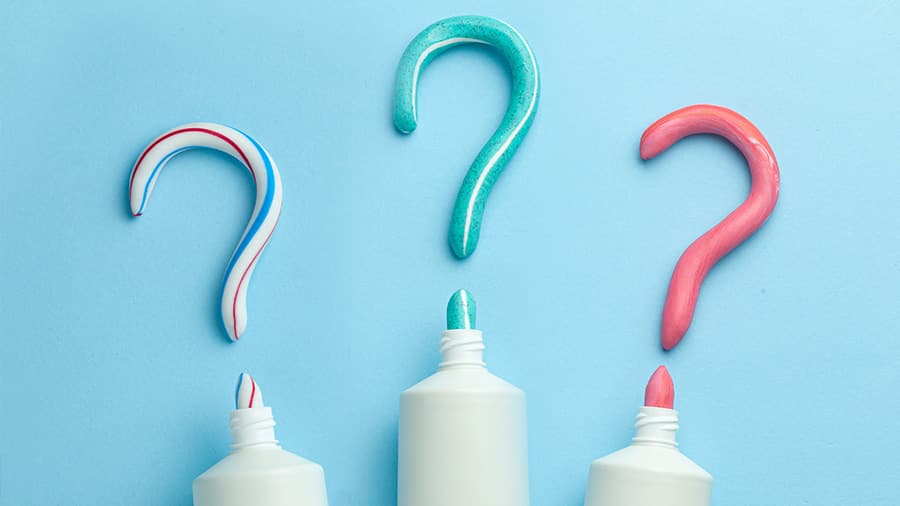What is Tooth Discoloration?
According to the Indian Dental Association, tooth discoloration is when the hard outer surface of the tooth (tooth enamel), or the layer below the enamel (dentine) becomes discoloured. The tooth may appear less white, turn yellow or darken, or develop white or dark spots. A change in the shade of your teeth can be of 3 types.
Try Colgate Visible White O2 to get rid of stains and discolouration, get a real white smile!
Types of Tooth Discoloration
Tooth discoloration falls into three primary categories: extrinsic, originating from external factors; and intrinsic, stemming from internal factors; and age-related changes.
1. Extrinsic discoloration - Extrinsic discolouration occurs due to stains on the tooth's outer surface or the enamel. Regular consumption of deeply colored items like red wine, coffee, and tea as well as the use of tobacco products like cigarettes and chewing tobacco, can lead to the accumulation of staining pigments on the tooth surface over time.
2. Intrinsic discoloration - Intrinsic discolouration is caused by stains that occur within the enamel. It could affect the dentin, the layer beneath the tooth enamel. Unlike extrinsic stains that occur on the tooth's surface, intrinsic stains are embedded within the tooth itself, making them more challenging to remove through regular dental hygiene practices.
3. Age-related discolouration - With age and regular wear and tear, the enamel of your teeth can become thinner, revealing the yellowish dentin beneath.
Tooth Discoloration Causes
According to IDA, factors contributing to tooth discoloration include consumption of foods or beverages that can stain, nicotine usage, poor oral hygiene, genetics, ageing, dental trauma or injuries, and certain diseases or medications. Let’s look at these factors one by one.
Foods and drinks: Regular consumption of pigmented foods and beverages can stain teeth. Coffee, tea, red wine, blueberries, and curry are some of these. Brushing post consumption of such foods and drinks can help prevent stains from forming.
Nicotine use: Smoking and chewing tobacco can discolour teeth.
Poor dental hygiene: Not brushing adequately or flossing regularly can lead to stains because of plaque build-up.
Genetics: Natural tooth colour and brightness vary from person to person. The natural colour of your dentin and the thickness of your enamel can determine how white your teeth appear.
Ageing: With age, the outer enamel layer may wear away and get thinner. This could expose the underlying dentin, imparting a yellowish hue to the teeth.
Dental trauma or injuries: Tooth injuries may occur from falls, sports activities, or accidents. The damaged tooth may appear darker.
Diseases or medications: Diseases that affect the thickness of tooth enamel or its calcium content, or metabolic diseases can be the cause of tooth discoloration in some people. Certain medications can also cause discolouration.
Degrees of Tooth Discolouration & What They May Indicate
Dental professionals note that various degrees of tooth discoloration include yellow, brown, black, grey, blue, and white. These colours can indicate different things.
1. Yellow/Brown Teeth Discoloration
Tobacco use remains a significant factor.
Drinks such as tea, coffee, cola, and red wine play a role in brown discolouration.
Untreated tooth decay and tartar build-up are common causes.
Diets high in simple sugars may contribute to yellow discolouration.
Certain medications, poor oral hygiene, and chronic dry mouth can also play a role.
A yellow tint near the gum line often indicates tartar build-up from accumulated dental plaque. Tartar requires professional dental cleaning for removal.
2. Black Stains
Advanced dental cavities, fillings, and silver sulphide crowns can cause black spots.
The use of liquid iron supplements may contribute to black staining.
3. Grey or Blue Teeth
Bluish-grey stains on teeth may result from exposure to tetracycline (an antibiotic) at an early age.
4. White Spots
Cavities can result in white spots that darken with advancement.
Tooth Discoloration Treatments
Teeth whitening treatments can include in-office whitening, dentist-supplied products for use at home, and over-the-counter products such as whitening toothpaste.
In-office Whitening
Professional teeth whitening options offered by dentists may include custom-made trays with gels for in-office application or at-home use. In some cases, the dentist may use other techniques, such as veneers, and dental bonding, to remove tough stains.
Over-the-counter Products
Dental professionals may suggest professional teeth-whitening products that can be used at home. They come in various forms like whitening toothpaste, strips, and gels. Whitening toothpastes offer a convenient and accessible solution. Whitening toothpastes usually contain mild abrasive materials that can polish your teeth and get rid of stains or few come with active ingredients like hydrogen peroxide that can effectively remove tooth stains for a brighter smile. Though hydrogen peroxide is an effective bleaching agent for teeth, in India it is not available as an over-the-counter product. However, a similar effect can be derived from the oxygenated whitening of Visible White O2 toothpaste and it is a safe and advanced technology.
Tooth Discoloration Prevention And Care
Tooth Discoloration can be prevented by adopting a few simple lifestyle changes such as:
- Regular brushing with fluoride-based teeth whitening toothpaste, supplemented by a *tooth whitening serum, can provide enhanced whitening results.
Daily flossing and using mouthwashes and mouth rinses to enhance oral hygiene
Limiting the intake of stain-inducing foods and drinks
Drinking water and rinsing the mouth after consuming foods and beverages
Quitting smoking and tobacco use
Scheduling routine dental cleanings and examinations
Tooth discoloration is a common concern. With the right care and treatment, you can regain a brighter, whiter smile. One may opt for professional dental procedures or explore over-the-counter products for teeth whitening. Being mindful of oral hygiene and lifestyle choices is the key.
*for temporary efficacy.
*vs brushing with Colgate non whitening toothpaste alone.
Frequently Asked Questions
What do healthy teeth look like?
Healthy teeth usually have smooth and intact surfaces. They may be clean and have no caries or cavities. They should be free of cracks or irregularities that create bacteria or plaque buildup leading to tooth decay or other dental issues.
Can I whiten my teeth at home?
Over-the-counter whitening products, like whitening toothpaste or whitening strips, can help with surface stains. Professional treatments also offer more robust and lasting results.
How often should I visit the dentist to maintain tooth colour?
Regular dental check-ups every six months are ideal for monitoring tooth health, catching issues early, and discussing preventive measures to maintain tooth colour. Using teeth-whitening toothpaste also helps retain a brighter smile, as it is more effective in removing tooth stains than regular toothpaste.
Is tooth discoloration reversible?
Tooth discoloration treatments may vary from person to person. Dental professionals may suggest over-the-counter products or dental treatments that lighten the tooth colour.
Can I fix a discoloured tooth?
Individuals may use teeth whitening products at home as suggested by a dental professional. They can be whitening toothpaste, rinses, strips, or trays. Whitening toothpastes offer a convenient and accessible solution with more effectiveness in stain removal and lightening of tooth shade than regular ones.
Why do aged people experience tooth discoloration more?
Ageing adults are prone to discoloration due to thinning of tooth enamel, persistent staining from years of consuming staining substances, and accumulated damage from wear and tear or injuries.
This article is intended to promote understanding of and knowledge about general oral health topics. It is not intended to be a substitute for professional advice, diagnosis or treatment. Always seek the advice of your dentist or other qualified healthcare provider with any questions you may have regarding a medical condition or treatment.
ORAL HEALTH QUIZ
What's behind your smile?
Take our Oral Health assessment to get the most from your oral care routine
ORAL HEALTH QUIZ
What's behind your smile?
Take our Oral Health assessment to get the most from your oral care routine













